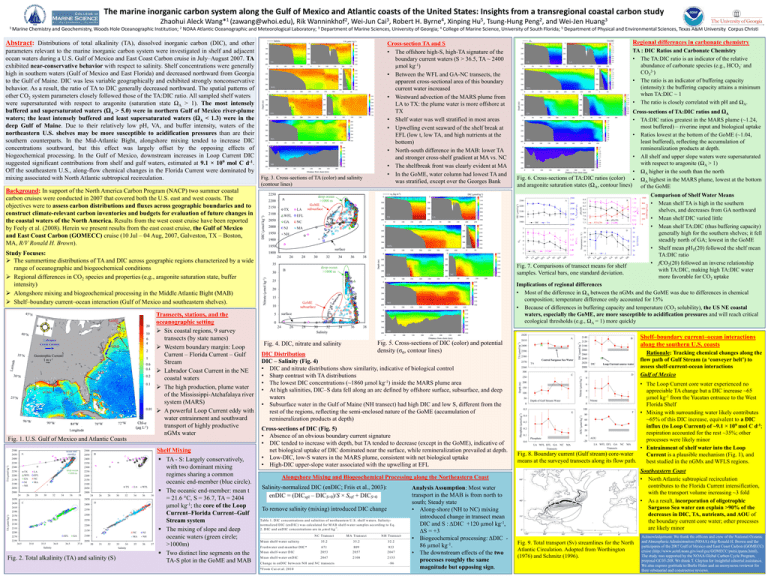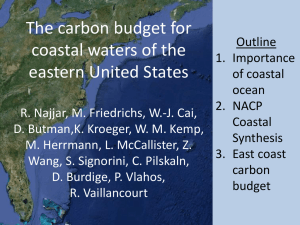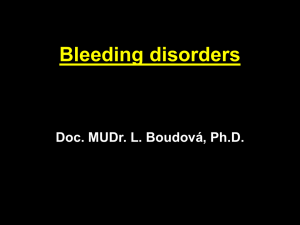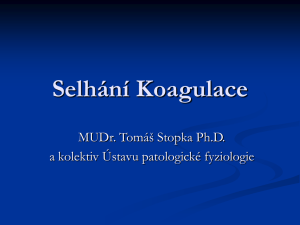2013_Poster_Wang_163_19 - North American Carbon Program
advertisement

The marine inorganic carbon system along the Gulf of Mexico and Atlantic coasts of the United States: Insights from a transregional coastal carbon study Zhaohui Aleck Wang*1 (zawang@whoi.edu), Rik Wanninkhof2, Wei-Jun Cai3, Robert H. Byrne4, Xinping Hu5, Tsung-Hung Peng2, and Wei-Jen Huang3 Chemistry and Geochemistry, Woods Hole Oceanographic Institution; 2 NOAA Atlantic Oceanographic and Meteorological Laboratory; 3 Department of Marine Sciences, University of Georgia; 4 College of Marine Science, University of South Florida; 5 Department of Physical and Environmental Sciences, Texas A&M University Corpus Christi Abstract: Distributions of total alkalinity (TA), dissolved inorganic carbon (DIC), and other TA (µmol kg-1) 2450 2400 2400 2350 2350 2300 2300 2250 TX WFL GA NJ NH 2200 2150 2100 2050 deep ocean >1000 m LA EFL NC MA 2250 2200 2150 2100 2050 2000 TX LA WFL 32 34 36 2000 24 26 28 30 32 34 36 38 2430 24 C 28 30 38 D 2400 2410 2350 2390 2370 2300 2350 2250 2330 2200 2310 2150 2290 EFL 2270 2250 34.5 26 2450 2450 TA (µmol kg-1) B 2100 GA NC NJ MA NH 35 36 2050 35.0 35.5 36.0 36.5 37.0 30 31 32 Salinity Fig. 2. Total alkalinity (TA) and salinity (S) 33 34 Salinity 37 Shelf Mixing TA - S: Largely conservatively, with two dominant mixing regimes sharing a common oceanic end-member (blue circle). The oceanic end-member: mean t = 21.6 °C, S = 36.7, TA = 2404 μmol kg-1; the core of the Loop 1 Current–Florida Current–Gulf Stream system The mixing of slope and deep oceanic waters (green circle; >1000m) Two distinct line segments on the TA-S plot in the GoME and MAB WFL EFL GA NC -1 2200 2300 2100 2200 2000 1900 DIC TA 7 C 6 NH 5 A 1850 surface 1800 4 1.10 3 1.05 2 A 1 32 34 36 38 TX 35 25 15 GoME subsurface surface 0 26 28 0.90 0 38 30 36 25 34 20 32 15 30 10 28 t TX NH S LA WFL EFL 26 GA NC MA NH 30 32 Salinity 34 36 38 2420 Fig. 5. Cross-sections of DIC (color) and potential density (σ0, contour lines) Fig. 4. DIC, nitrate and salinity DIC Distribution DIC – Salinity (Fig. 4) • DIC and nitrate distributions show similarity, indicative of biological control • Sharp contrast with TA distributions • The lowest DIC concentrations (~1860 µmol kg-1) inside the MARS plume area • At high salinities, DIC–S data fell along an arc defined by offshore surface, subsurface, and deep waters • Subsurface water in the Gulf of Maine (NH transect) had high DIC and low S, different from the rest of the regions, reflecting the semi-enclosed nature of the GoME (accumulation of remineralization products at depth) Cross-sections of DIC (Fig. 5) • Absence of an obvious boundary current signature • DIC tended to increase with depth, but TA tended to decrease (except in the GoME), indicative of net biological uptake of DIC dominated near the surface, while remineralization prevailed at depth. • Low-DIC, low-S waters in the MARS plume, consistent with net biological uptake • High-DIC upper-slope water associated with the upwelling at EFL 2140 A 2410 B 2120 -1 24 MA DIC ( mol kg ) 5 NC 200 Implications of regional differences • Most of the difference in ΩA between the nGMx and the GoME was due to differences in chemical composition; temperature difference only accounted for 15% • Because of differences in buffering capacity and temperature (CO2 solubility), the US NE coastal waters, especially the GoME, are more susceptible to acidification pressures and will reach critical ecological thresholds (e.g., ΩA = 1) more quickly 20 10 GA 2400 2390 2380 2370 Central Sargasso Sea Water 2100 2080 2060 2040 2020 TA 2360 2000 300 10 250 DIC Loop Current source water D C 8 Salinity-normalized DIC (enDIC; Friis et al., 2003): enDIC = (DICspl – DICS=0)/S × Sref + DICS=0 To remove salinity (mixing) introduced DIC change T able 1. D IC con centrations and salinities of northeastern U .S . shelf w aters. S alinitynorm alized D IC (enD IC ) w as calculated for M A B shelf-w ater sam ples according to E q. -1 2. D IC and enD IC concentrations are in µ m ol kg . N C T ransect M A T ransect N H T ransect M ean shelf-w ater salinity 35.2 33.2 32.2 F reshw ater end -m em ber D IC * 671 809 933 M ean shelf-w ater D IC 2053 2057 2047 M ean shelf-w ater enD IC 2047 2108 2133 C hange in enD IC betw een N H and N C transects –86 Analysis Assumption: Most water transport in the MAB is from (2) north to south; Steady state • Along-shore (NH to NC) mixing introduced change in transect mean DIC and S : ΔDIC +120 µmol kg-1, ΔS = +3 • Biogeochemical processing: ΔDIC 86 µmol kg-1. • The downstream effects of the two processes roughly the same magnitude but opposing sign. Shelf–boundary current–ocean interactions along the southern U.S. coasts Rationale: Tracking chemical changes along the flow path of Gulf Stream (a ‘conveyer belt’) to assess shelf-current-ocean interactions Gulf of Mexico • The Loop Current core water experienced no 4 appreciable TA change but a DIC increase ~65 100 -1 from the Yucatan entrance to the West 2 50 µmol kg Nitrate Depth of Gulf Stream Water 0 0 Florida Shelf LA WFLEFL GA NC MA 100 0.5 F E • Mixing with surrounding water likely contributes 80 0.4 60 ~65% of this DIC increase, equivalent to a DIC 0.3 40 9 mol C d-1; influx (to Loop Current) of ~9.1 × 10 0.2 20 respiration accounted for the rest ~35%; other 0.1 0 AOU Phosphate processes were likely minor -20 0.0 LA WFL EFL GA NC MA LA WFL EFL GA NC MA Transects • Entrainment of shelf water into the Loop Transects Fig. 8. Boundary current (Gulf stream) core-water Current is a plausible mechanism (Fig. 1), and means at the surveyed transects along its flow path. best studied in the nGMx and WFLS regions. 200 150 6 Southeastern Coast • North Atlantic subtropical recirculation contributes to the Florida Current intensification, with the transport volume increasing ~3 fold • As a result, incorporation of oligotrophic Sargasso Sea water can explain >90% of the decreases in DIC, TA, nutrients, and AOU of the boundary current core water; other processes are likely minor Alongshore Mixing and Biogeochemical Processing along the Northeastern Coast *F rom C ai et al. 2010 400 0.95 Fig. 7. Comparisons of transect means for shelf samples. Vertical bars, one standard deviation. deep ocean >1000 m B 30 LA WFL EFL pHT(20) TA:DIC fCO2(20) 5 Nitrate ( mol kg-1) 30 TA ( mol kg ) 28 Depth (m) 26 Phosphate ( mol kg-1) 24 0.95 600 1.00 D 1.00 TA:DIC 8.0 35 1.20 1.15 1900 1.05 Comparison of Shelf Water Means • Mean shelf TA is high in the southern shelves, and decreases from GA northward • Mean shelf DIC varied little • Mean shelf TA:DIC (thus buffering capacity) generally high for the southern shelves; it fell steadily north of GA; lowest in the GoME • Shelf mean pHT(20) followed the shelf mean TA:DIC ratio • fCO2(20) followed an inverse relationship with TA:DIC, making high TA:DIC water more favorable for CO2 uptake AOU ( mol kg-1) 1950 MA 800 1.10 7.7 Temperature (t, °C) NJ 1.15 8.1 7.8 2000 2000 8.2 7.9 2100 2050 B 8.3 pHT(20) 2100 LA DIC ( mol kg ) DIC (µmol kg-1) TX 2400 1000 fCO2(20) ( atm) A 2450 2500 ocean endmember 2150 8.4 A 2300 1.20 Salinity (S) 2500 A 2200 2500 TA:DIC Fig. 1. U.S. Gulf of Mexico and Atlantic Coasts deep ocean >1000 m GoME subsurface Cross-sections of TA:DIC ratios and ΩA • TA:DIC ratios greatest in the MARS plume (~1.24, most buffered) – riverine input and biological uptake • Ratios lowest at the bottom of the GoME (~1.04, least buffered), reflecting the accumulation of remineralization products at depth. • All shelf and upper slope waters were supersaturated with respect to aragonite (ΩA > 1) • ΩA higher in the south than the north Fig. 6. Cross-sections of TA:DIC ratios (color) • ΩA highest in the MARS plume, lowest at the bottom and aragonite saturation states (ΩA, contour lines) of the GoME TA:DIC Transects, stations, and the oceanographic setting Six coastal regions, 9 survey transects (by state names) Western boundary margin: Loop Current – Florida Current – Gulf Stream Labrador Coast Current in the NE coastal waters The high production, plume water of the Mississippi-Atchafalaya river system (MARS) A powerful Loop Current eddy with water entrainment and southward transport of highly productive nGMx water 2250 TA : DIC Ratios and Carbonate Chemistry • The TA:DIC ratio is an indicator of the relative abundance of carbonate species (e.g., HCO3- and CO32-) • The ratio is an indicator of buffering capacity (intensity): the buffering capacity attains a minimum when TA:DIC ~ 1 • The ratio is closely correlated with pH and ΩA. -1 Study Focuses: The summertime distributions of TA and DIC across geographic regions characterized by a wide range of oceanographic and biogeochemical conditions Regional differences in CO2 species and properties (e.g., aragonite saturation state, buffer intensity) Alongshore mixing and biogeochemical processing in the Middle Atlantic Bight (MAB) Shelf–boundary current–ocean interaction (Gulf of Mexico and southeastern shelves). Fig. 3. Cross-sections of TA (color) and salinity (contour lines) Regional differences in carbonate chemistry TA ( mol kg ) Background: In support of the North America Carbon Program (NACP) two summer coastal carbon cruises were conducted in 2007 that covered both the U.S. east and west coasts. The objectives were to assess carbon distributions and fluxes across geographic boundaries and to construct climate-relevant carbon inventories and budgets for evaluation of future changes in the coastal waters of the North America. Results from the west coast cruise have been reported by Feely et al. (2008). Herein we present results from the east coast cruise, the Gulf of Mexico and East Coast Carbon (GOMECC) cruise (10 Jul – 04 Aug, 2007, Galveston, TX – Boston, MA, R/V Ronald H. Brown). Cross-shelf Gradients Nitrate (µmol kg-1) parameters relevant to the marine inorganic carbon system were investigated in shelf and adjacent ocean waters during a U.S. Gulf of Mexico and East Coast Carbon cruise in July–August 2007. TA exhibited near-conservative behavior with respect to salinity. Shelf concentrations were generally high in southern waters (Gulf of Mexico and East Florida) and decreased northward from Georgia to the Gulf of Maine. DIC was less variable geographically and exhibited strongly nonconservative behavior. As a result, the ratio of TA to DIC generally decreased northward. The spatial patterns of other CO2 system parameters closely followed those of the TA:DIC ratio. All sampled shelf waters were supersaturated with respect to aragonite (saturation state ΩA > 1). The most intensely buffered and supersaturated waters (ΩA > 5.0) were in northern Gulf of Mexico river-plume waters; the least intensely buffered and least supersaturated waters (ΩA < 1.3) were in the deep Gulf of Maine. Due to their relatively low pH, VA, and buffer intensity, waters of the northeastern U.S. shelves may be more susceptible to acidification pressures than are their southern counterparts. In the Mid-Atlantic Bight, alongshore mixing tended to increase DIC concentrations southward, but this effect was largely offset by the opposing effects of biogeochemical processing. In the Gulf of Mexico, downstream increases in Loop Current DIC suggested significant contributions from shelf and gulf waters, estimated at 9.1 × 109 mol C d-1. Off the southeastern U.S., along-flow chemical changes in the Florida Current were dominated by mixing associated with North Atlantic subtropical recirculation. Cross-section TA and S • The offshore high-S, high-TA signature of the boundary current waters (S > 36.5, TA ~ 2400 µmol kg-1) • Between the WFL and GA-NC transects, the apparent cross-sectional area of this boundary current water increased • Westward advection of the MARS plume from LA to TX: the plume water is more offshore at TX • Shelf water was well stratified in most areas • Upwelling event seaward of the shelf break at EFL (low t, low TA, and high nutrients at the bottom) • North-south difference in the MAB: lower TA and stronger cross-shelf gradient at MA vs. NC • The shelfbreak front was clearly evident at MA • In the GoME, water column had lowest TA and was stratified, except over the Georges Bank -1 1 Marine Fig. 9. Total transport (Sv) streamlines for the North Atlantic Circulation. Adopted from Worthington (1976) and Schmitz (1996). Acknowledgement: We thank the officers and crew of the National Oceanic and Atmospheric Administration (NOAA) ship Ronald H. Brown and the participants of the 2007 Gulf of Mexico and East Coast Carbon (GOMECC) cruise (http://www.aoml.noaa.gov/ocd/gcc/GOMECC/participants.html). The study was supported by the NOAA Global Carbon Cycle Program, proposal GC05-208. We thank T. Clayton for insightful editorial assistance. We also express gratitude to Burke Hales and an anonymous reviewer for their substantial and constructive reviews.








